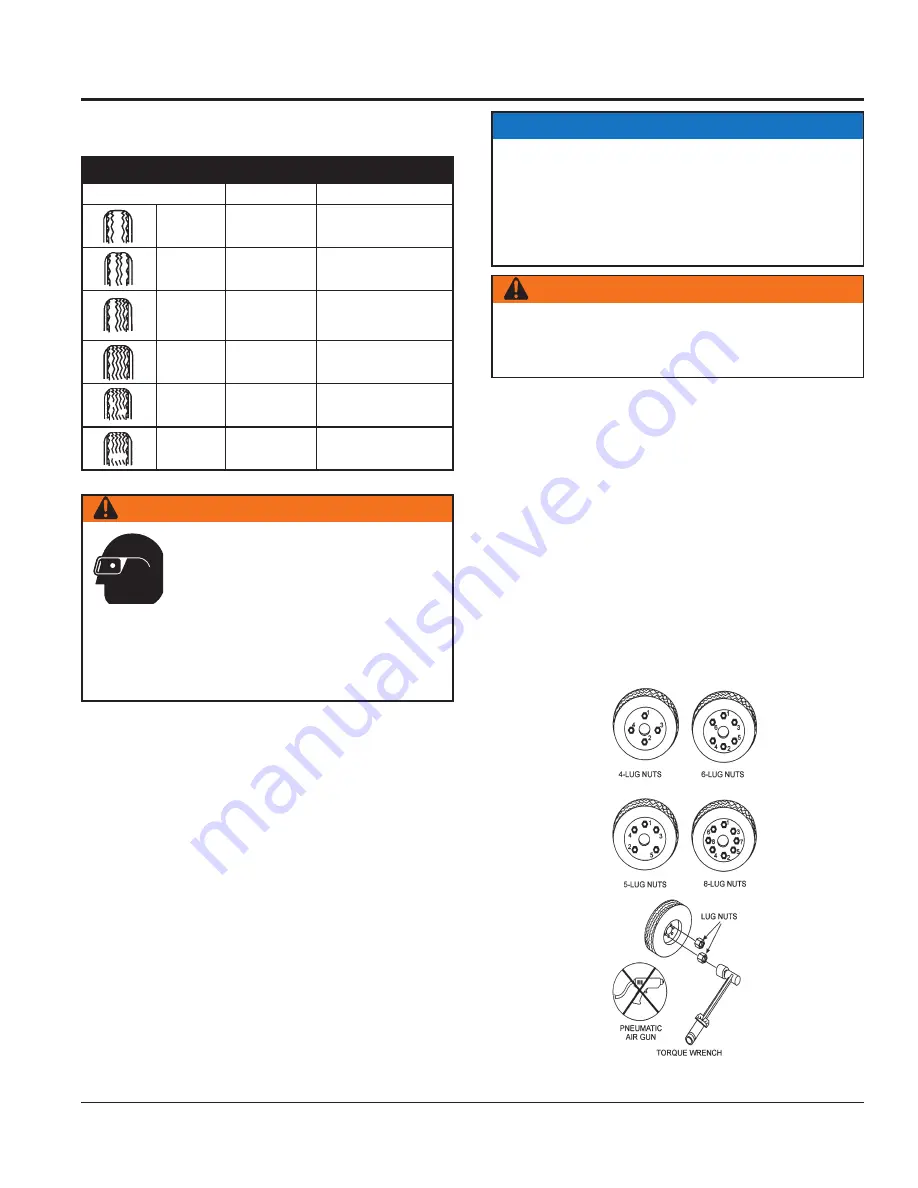
WT5C SERIES WATER TRAILER • OPERATION MANUAL — REV. #6 (05/28/21) — PAGE 49
TRAILER SAFETY GUIDELINES
Table B below will help pinpoint the causes and solutions
of tire wear problems.
Wheel Rims
If the trailer has been struck, or impacted, on or near the
wheels, or if the trailer has struck a curb, inspect the rims for
damage (i.e. being out of round), and replace any damaged
wheel. Inspect the wheels for damage every year, even if
no obvious impact has occurred.
Wheels, Bearings and Lug Nuts
A loose, worn or damaged wheel bearing is the most
common cause of brakes that grab.
To check wheel bearings, jack trailer and check wheels
for side-to-side looseness. If the wheels are loose, or spin
with a wobble, the bearings must be serviced or replaced.
Check infl ation pressure weekly during use to ensure the
maximum tire life and tread wear. Most trailer axles are
built with sealed bearings that are not serviceable. Sealed
bearings must be replaced as complete units.
Table B. Tire Wear Troubleshooting
Wear Pattern
Cause
Solution
Center Wear Over infl ation.
Adjust pressure to particular
load per tire manufacturer.
Edge Wear
Under infl ation.
Adjust pressure to particular
load per tire manufacturer.
Side Wear
Loss of camber
or overloading.
Make sure load does not
exceed axle rating.
Align wheels.
Toe Wear
Incorrect toe-in.
Align wheels.
Cupping
Out-of-balance.
Check bearing adjustment
and balance tires.
Flat Spots
Wheel lockup and
tire skidding.
Avoid sudden stops when
possible and adjust brakes.
WARNING
ALWAYS wear safety glasses when
removing or installing force-fi tted parts.
DO
NOT
attempt to repair or modify a wheel.
DO NOT install an inner-tube to correct a
leak through the rim. If the rim is cracked,
the air pressure in the inner tube may cause pieces of
the rim to explode (break off) with great force and cause
serious eye or bodily injury.
Lug Nut Torque Requirements
It is extremely important to apply and maintain proper wheel
mounting torque on the trailer. Be sure to use only the
fasteners matched to the cone angle of the wheel. Proper
procedure for attachment of the wheels is as follows:
1. Start all wheel lug nuts by hand.
2. Torque all lug nuts in sequence. See Figure L. DO NOT
torque the wheel lug nuts all the way down. Tighten
each lug nut in 3 separate passes as defined by
Table C.
3. Check to see if the lug nuts are tight after the fi rst 10,
25 and 50 miles of driving and before each tow
thereafter.
Figure L. Wheel Lug Nuts Tightening Sequence
WARNING
Lug nuts are prone to loosen after initial installation,
which can lead to death or serious injury. Check all
wheel lug nuts periodically.
NOTICE
NEVER
use a pneumatic air gun to tighten wheel lug
nuts.
Over-tightening lug nuts will result in breaking the studs
or permanently deforming the mounting stud holes in
the wheels.






































